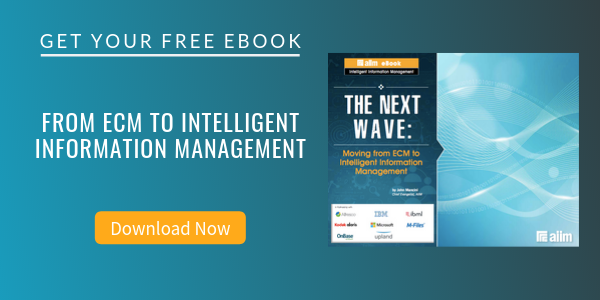
Back of the Napkin Noodlings on the Lifecycle of ECM
Enterprise Content Management (ECM)
A few of us were playing around the other night with a new conceptual framework for talking about the lifecycle of ECM. I've attached our back of the napkin thoughts, along with a bit of explanation for the layers. We'd be interested to learn what you think.
The Top Layer: Manage – Content and Process
Focuses on the fundamental purpose of making an investment in ECM – practice, and technologies. How do you meet your core business goals of enhancing productivity, reducing risk and cost, and encouraging innovation, when these are often in conflict with each other?
The Middle Layer: What the end-user does
A user-centric overview of the fundamental capabilities of ECM. These are the tasks and activities most business users will perform. All other elements are/should be background services to deliver the automation, compliance, process efficiencies behind the scenes.
- Create/Capture – The intake of enterprise content, regardless of the format. From traditional paper scanning, to email filing, integration with office suites, to capture of rich media or graphics, and social media content created for business purpose.
- Organize – End users will categorize, add metadata or tags, drag into folders – this organization feeds the background processes or retention & disposition rules. Identification of content types, topics, subjects may kick off automated workflows or processes, invoke lifecycle rules, inherit security controls, and will form a strong foundation for findability via search, indexing, and recommendation/personalization engines.
- Collaborate – Share content and work interactively with peers. Annotate or markup work-in-progress content, create new versions, track edits and activity, comment and discuss issues, create shared team workspaces and interactive forums, share experiences or information, and build shared knowledge bases.
- Search and Retrieve – Query the repository by using keywords or phrases, use metadata or tags, share search results, store routine queries for later use, navigate virtual folders, create relationships between documents, discover relevant content from experts
- Publish and Deliver – Push finalized content to interested users by publishing to an intranet, extranet, or public web sites, render content into standard formats for exchange or preservation, aggregate, or export-related content into folders, workspaces, external locations, create compound documents out of assembled individual items.
The Bottom Layer – Information Architecture
Information architecture is the technical expression of an organization's information management strategy. Technologies deployed to automate, streamline, and accelerate the management of enterprise content, the processes it supports by providing rules, security controls, and repository services.
- Metadata – System generated and organization-define identifiers and tags to organize, categorize content, and trigger processes and business rules.
- Taxonomy – A structure for an enterprise's information, gives shape to the metadata, provide consistency for users and administrators to define and describe information regardless of the format or source
- Retention, Preservation, Disposal – essential final phases of content lifecycle, allowing businesses to establish consistent rules for the destruction, long-term preservation, or handling of content regardless of format.
What do you think?
About John Mancini
John Mancini is the President of Content Results, LLC and the Past President of AIIM. He is a well-known author, speaker, and advisor on information management, digital transformation and intelligent automation. John is a frequent keynote speaker and author of more than 30 eBooks on a variety of topics. He can be found on Twitter, LinkedIn and Facebook as jmancini77. Recent keynote topics include: The Stairway to Digital Transformation Navigating Disruptive Waters — 4 Things You Need to Know to Build Your Digital Transformation Strategy Getting Ahead of the Digital Transformation Curve Viewing Information Management Through a New Lens Digital Disruption: 6 Strategies to Avoid Being “Blockbustered” Specialties: Keynote speaker and writer on AI, RPA, intelligent Information Management, Intelligent Automation and Digital Transformation. Consensus-building with Boards to create strategic focus, action, and accountability. Extensive public speaking and public relations work Conversant and experienced in major technology issues and trends. Expert on inbound and content marketing, particularly in an association environment and on the Hubspot platform. John is a Phi Beta Kappa graduate of the College of William and Mary, and holds an M.A. in Public Policy from the Woodrow Wilson School at Princeton University.



